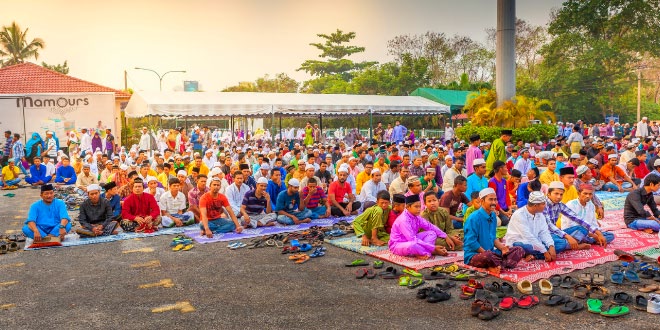Eid-ul-Fitr Customs & Traditions
On the morning of Eid, Muslims all over the world take bath and have their breakfast, typically comprising of dates and sweets. They wear new clothes on this occasion and visit the mosque (masjid) to worship Allah. Special Eid-ul-Fitr prayer ceremony is carried out in open areas, under the sky. All the Muslims recite Takbir, a poem in the praise of the greatness of Allah. It starts at the time of the sighting of crescent moon and lasts till the prayers are said. Muslims are supposed to pay Zakat al Fitr i.e. a donation for the month of Ramzan. This donation is given at a nearby mosque, to begin the Eid prayer.
Zakat al Fitr can be given in way of money or eatables like dates, wheat, barley, raisins etc. After the prayer, the Imam, or the spiritual head delivers a discourse on social and family duties, also known as Khutba (sermons). Everyone prays for forgiveness for their sins and for protection against misfortune, after which people embrace and greet each other with ‘Eid Mubarak‘ or ‘Happy Eid‘ and head back home for the feast! It is customary to embrace the person sitting on your either side, after the prayers are over. Near and dear ones are also embraced.
On Eid, women pray at home and then get busy organizing a lavish spread of eatables, like sivai – the special sweet for Eid (vermicelli cooked in milk and sugar), dry fruits, sweetmeats, biryani (meat cooked in spicy rice) and other things. They don new clothes and pay special heed to their make-up. The men return home to their beautiful wives and the family sits down for the grand meal. People embrace each other and exchange greetings of ‘Eid Mubarak’. Non-Muslims make it a point to visit their Muslim friends to join in their happiness and especially to consume some of the scrumptious food made for Eid-ul-Fitr.
Customs of exchanging gifts
Gifts are also exchanged on the festive occasion of Id. Daughters and married sisters are, especially, given gifts. In fact, brothers pay a visit to their married sisters and take sivai and other eatables, along with clothes, bangles and money. Children also receive money from elders, known as eiddi. Celebrations extend to three days of merry-making and enjoyment. While in countries like India, Eid-ul-Fitr calls for a one day holiday all across the country, in some nations, Eid holidays span up to three days. Every country has its own way of celebrating Id, but most of the customs and traditions remain similar around the world.
 Kids Portal For Parents India Kids Network
Kids Portal For Parents India Kids Network







